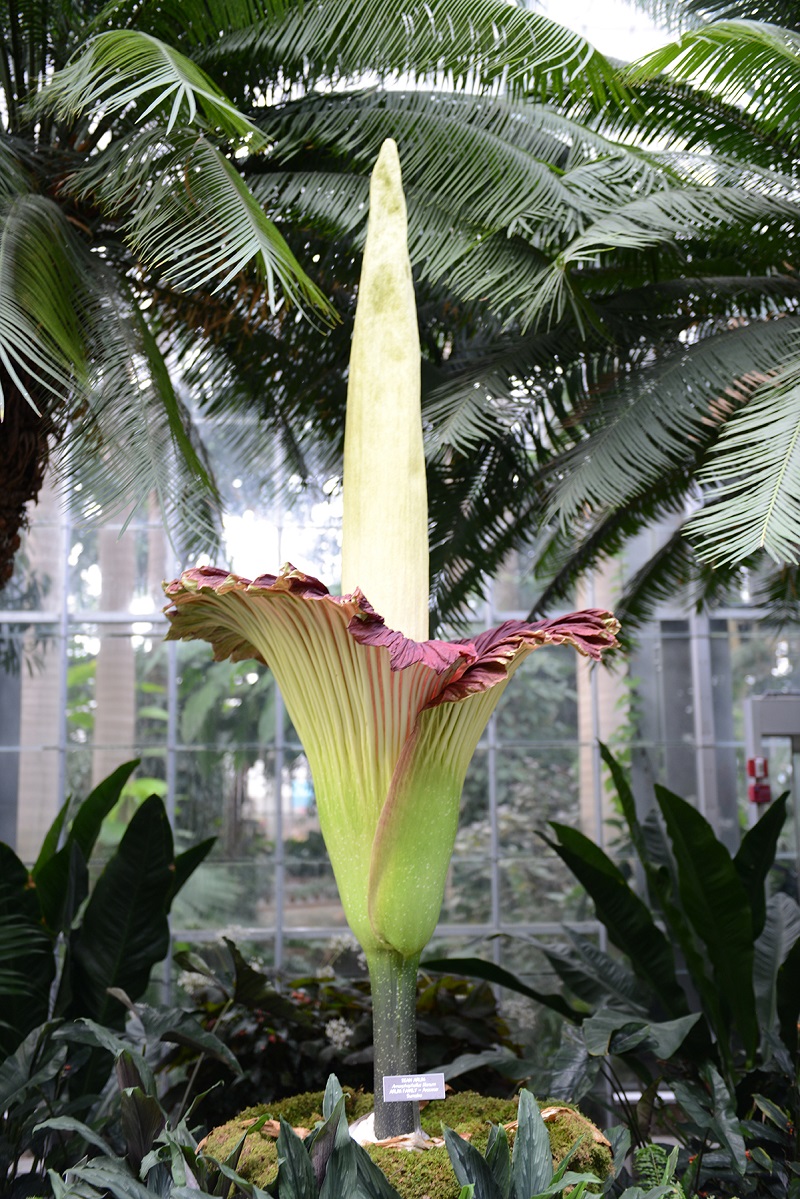
Smell Ya Later: Corpse Flower in its Death Throes

WASHINGTON — A corpse flower in its death throes doesn't smell like a corpse at all.
A titan arum (or "corpse flower") housed here at the U.S. Botanic Garden Conservatory has been smelling up its exhibition hall to the delight of thousands of visitors since the tropical flower finally went into full bloom on Sunday (July 21), but its time in bloom is quickly coming to a close.
A corpse flower's rare malodorous bloom only lasts for 24 to 48 hours, after which time it closes up and collapses.
"We've already reached that stage where the plant is showing signs of beginning to pack it in," Ari Novy, a plant scientist and public programs manager at the U.S. Botanic Garden, said. "Over the course of the next several days, the whole plant will essentially fall apart." [In Images: A Corpse Flower Blooms]
'Really, really unpleasant'
Although the line to get in to see the blooming corpse flower stretched around the block when the building opened at 10 a.m. EDT (1400 GMT), the corpse flower did not live up to its smelly moniker.
Instead of the rotting flesh odor that is typical of a blooming corpse flower, visitors were greeted with the smells emitted by other fans of the stinky plant. Body odor and perfume were the prevailing aromas dominating the corpse flower's hall today (July 23).
Sign up for the Live Science daily newsletter now
Get the world’s most fascinating discoveries delivered straight to your inbox.
During the earlier part of the week, however, the plant was in peak form.
"On Sunday night — I was here at about 10:30 at night — I came in. It was really, really smelly. I could smell it before I got into that room," Novy told LiveScience's OurAmazingPlanet. "Then once you get into that room, it really hits you pretty hard. It reminded me of a dead deer on the side of the road in the Florida Everglades with a big pile of really soggy, moldy laundry next to it. It was really, really unpleasant." [Why the Corpse Flower Reeks]
The foul smell given off by the corpse flower — scientifically named Amorphophallus titanium — has a very specific purpose. The plant uses its rotten aroma to attract flesh-eating critters like carrion beetles and flies that will carry its pollen to potentially cross pollinate other corpse flowers.
The titan arum stretches to an impressive 8 feet (2.4 meters) in height, and the plants have been known to grow to be as much as 12 feet (3.7 m) tall. The titan arum is native to the rain forests of central Sumatra in western Indonesia.

The D.C. plant was about 4 feet (1.2 m) tall when it was put on display in the greenhouse. While in its current enclosure, the plant grew 5 to 8 inches (13 to 20 centimeters) per day, reaching its full 8-foot height in less than a week and a half, Novy said.
A titan arum can bloom more than once, however, these are fickle plants. This is the first time this particular corpse flower has bloomed, and it is the first to bloom in Washington, D.C., since 2007. The 2007 flower was part of a Smithsonian collection.
"These plants can be long-lived and there are absolutely records in botanic gardens or other horticultural institutions of these plants blooming multiple times in their life spans, but it's unpredictable," Novy said. "They can take as little as two or so years between blooms and there are recordings of them taking as many as 20 years between blooms."
'Freak of nature'
Despite the fact that the corpse flower's famous stench has dissipated, the bloom was still a sight to behold for many visitors.
Cormac Jensen, a 10-year-old visiting the gardens with his father, wasn't disappointed that the flower had already stopped giving off its odor.
"It doesn't really matter [that it doesn't smell]," Cormac told LiveScience. "It's still wonderful. It's a freak of nature."
Giccomo Caicella, Cormac's 12-year-old friend, was also impressed.
"It's a real treat to be here," Giccomo said. "It's really cool [seeing] all these other plants I haven't seen before."
Follow Miriam Kramer @mirikramer and Google+. Follow OurAmazingPlanet @OAPlanet, Facebook and Google+. Original article at LiveScience's OurAmazingPlanet.











